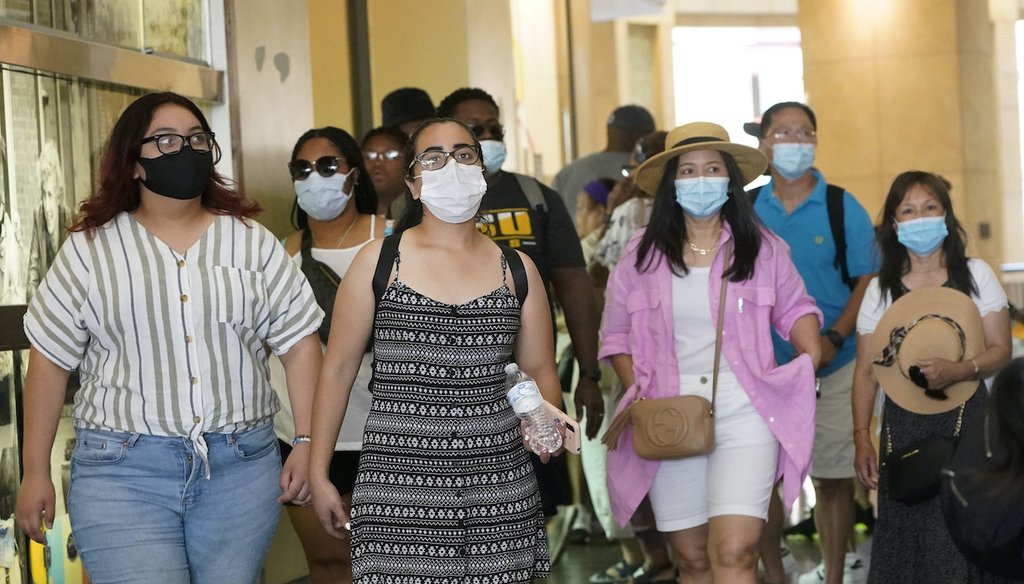

Our only agenda is to publish the truth so you can be an informed participant in democracy.
We need your help.


Visitors wear masks as they walk in a shopping district Thursday, July 1, 2021, in the Hollywood section of Los Angeles. (AP)
Vice wrote about research that assessed the effectiveness of popular "hacks" meant to improve the fit of KN95 and surgical masks.
The researchers evaluated seven different "fit hacks," some of which involved rubber bands, tape and pantyhose.
The study concluded that while some hacks improved the effectiveness of the masks, they were "very uncomfortable and unlikely to be tolerated for extended periods of time."
Throughout the COVID-19 pandemic, research into the most effective masks and the most effective way to wear masks has continued to evolve.
Now, some social media users have claimed that recommendations have changed once again.
A Facebook post by the group Young Americans for Liberty features a screenshot of a Vice article containing a bulleted list.
"The Covid Cult has some suggestions to make your mask more ‘effective,’" the caption of the Feb. 4 post said. "There are no words…"
The bulleted list reads:
Taping the edges of a mask to one’s face
Filling the sides of a mask with gauze
Binding the mask to the face with gauze (the ‘mummy’ method)
Putting a knot in the ear loops
Rubber bands around the front to create a ‘brace’ against the mouth
A slice of pantyhose wrapped around the face.
The post was flagged as part of Facebook’s efforts to combat false news and misinformation on its News Feed. (Read more about our partnership with Facebook.)
The image from the Facebook post shows a snippet of a Feb. 3 Vice article with the headline, "Scientists Find Putting Pantyhose on Your Head Makes Your Mask Safer." But the screenshot is missing context from the article.
In the Vice article, the list of potential ways to improve mask effectiveness follows an explanation of a study that was conducted largely by researchers from the University of Cambridge.
The researchers tested a variety of popular approaches to improving mask fit — termed "fit hacks" — to see if any would improve the performance of KN95 and surgical masks. The Facebook post screenshot showed the "fit hacks" that were tested.
Researchers assessed the fit of surgical and KN95 masks, both with and without the fit hacks, by taking air samples "to continuously measure the concentrations of particles both inside and outside of a donned mask."
The study found that nearly all of the hacks improved mask fit and made them more effective, and using a layer of pantyhose to hold masks more tightly to the face was the most effective. Individual facial features also impacted fit.
But the researchers said many of the hacks were "so uncomfortable as to be unusable in some cases."
Eugenia O’Kelly, a researcher at the University of Cambridge and the study’s lead author, acknowledged the limitations of the research.
"Using an effective but uncomfortable hack may make good sense in some high-risk situations, where the discomfort is worth it for the added protection," she said, "but it would be harder to wear these hacks day in and day out."
The researchers called for more study — particularly further research on cloth masks — and testing other fit hacks.
"We hope these results can be used in the design of future masks, in order to ensure that they are as tight to the face as possible, for as many wearers as possible, without making them uncomfortable," O’Kelly said.
The Centers for Disease Control and Prevention recommends people wear masks that fit snugly to the face and have layers. For the omicron variant, experts recommend layering cloth masks and surgical masks or wearing even more protective KN95s or N95s.
A Facebook post suggested that binding a mask to your face with gauze, wearing a section of pantyhose over your head and mask and other approaches were the newest "suggestions to make your mask more ‘effective.’"
The post frames the "fit hacks" shown in the screenshot as recommendations. The list was actually part of a Vice article that explained one study about ways to improve mask fit. By showing the list of "fit hacks" without context, the Facebook post mischaracterized both the Vice article and the research it was based on. The researchers acknowledged that most of the "hacks" were impractical.
We rate this post Half True.
Vice, "Scientists Find Putting Pantyhose on Your Head Makes Your Mask Safer," Feb. 3, 2022
PLOS One, "Face mask fit hacks: Improving the fit of KN95 masks and surgical masks with fit alteration techniques," Feb. 2, 2022
University of Cambridge, "Testing the effectiveness of KN95 and surgical mask ‘fit hacks,’" Feb. 2, 2022
Centers for Disease Control and Prevention, "Improve How Your Mask Protects You," April 6, 2021
Centers for Disease Control and Prevention, "Types of Masks and Respirators," Jan. 28, 2022
PolitiFact, "Ask KHN-Politifact: Is my cloth mask good enough? The 2022 edition," Jan. 12, 2022
PolitiFact, "Ask KHN-PolitiFact: Is my cloth mask good enough to face the delta variant?" Sept. 20, 2021
In a world of wild talk and fake news, help us stand up for the facts.
